Is the NPS Prepared for Tsunami Debris?
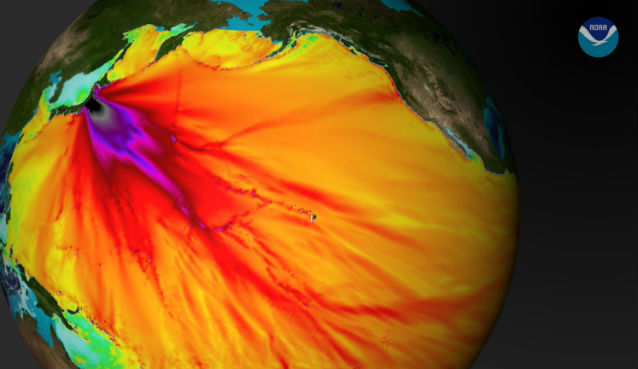
Courtesy NOAA
The tsunami that devastated Japan is a human tragedy—the disaster took more than 15,000 lives and destroyed whole communities. Now a year later, floating debris that washed into the ocean is landing on
U.S. and Canadian shores and will continue over several years. The NOAA Marine Debris Program (MDP) is leading the Japan Tsunami Marine Debris Assessment and Response Framework efforts with federal partners such as NPS along with state and local partners to collect data on debris quantity, location and movement, assess potential impacts, and plan for efforts to reduce possible impacts to our natural resources and coastal communities.
Because of the large potential area of debris drift in the North Pacific Ocean, it is critical to explore a broad range of methods for debris detection. Specific efforts to detect and track the debris field include by vessel, plane, satellite, modeling, and monitoring. Most scientists, though, expect that the debris will be difficult to distinguish from the normal marine debris that occurs in the North Pacific Gyre and washes ashore every day. The only indications that marine debris specifically from the Japan tsunami is making landfall may be changes in the quantity or the composition of debris compared to what is observed normally.
Nevertheless, NPS is working with NOAA to acquire baseline information on the marine debris that is currently stranding on U.S. coastlines in advance of the influx of tsunami debris. Using NOAA’s standardized shoreline monitoring protocols, baseline marine debris surveys will be conducted for a two-year period in several NPS units. Results of the monitoring will help indicate when and where Japan tsunami marine debris is making landfall and will inform regional contingency plans as they are developed by state and federal partners in all areas of potential impact. The NOAA MDP website has the latest information on the tsunami marine debris. Also, state partners have developed a website to focus on regional information.
Caring for the Coast in Kenai Fjords
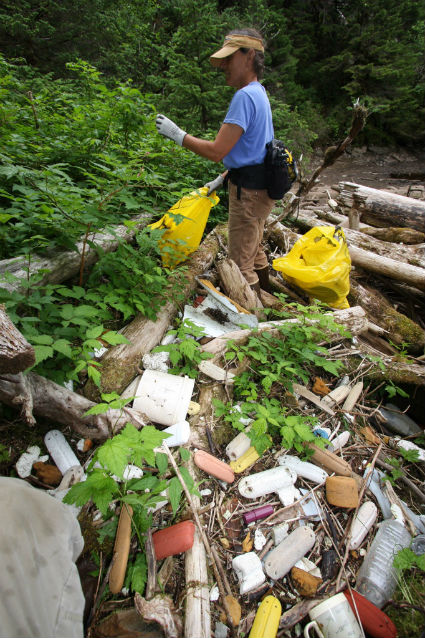
You might think that the least-visited parts of a national park would also be the areas that show the least impact from humans. But in some of the most remote areas of Alaska’s Kenai Fjords National Park, beaches that seldom see a human footprint are nonetheless littered with trash. Marine debris is a menace to the farthest reaches of our globe, and even designated national park lands are not immune.
This summer, the Resurrection Bay Conservation Alliance (RBCA) will be mounting a volunteer effort for the eighth year in a row to remove debris that fouls some of the beaches in Kenai Fjords National Park. Luckily, the problem is not widespread, and the more protected beaches that are popular with most kayakers are not subject to much debris accumulation. But on the Park’s seldom-visited outer coast, where beaches are exposed to the currents and storms of the Gulf of Alaska, the debris accumulation is substantial.
“It’s really deceiving up front,” says RBCA Marine Debris Coordinator Tim Johnson. “You’ve got this nice high tide line that looks quite pristine. Then you get back behind the storm berms, back into the lagoons and the vegetation behind the beach, and you see the extent of trash deposition.”
In 2009, the first summer that the RBCA was able to clean the more remote beaches around Thunder Bay, they removed more than 4 tons of trash from one rocky stretch less than a mile in length. Johnson figures that this was decades of accumulation. However, when they returned the following year to the same short stretch of beach, they bagged another ton of fresh debris, an indicator of the rapid deposition that takes place on these so-called “catcher” beaches. Their position in relation to the prevailing currents and storm tracks means that they catch a tremendous amount of debris.
The RBCA has worked closely with Kenai Fjords National Park to identify target beaches for cleanup, secure funds for cleanup vessels, avoid sensitive cultural sites, and ensure the safety of volunteers. “It’s really a partnership between the park service and the community to help get out and really get a project done that, in and of itself, any one group couldn’t do on their own,” according to Fritz Klasner, the former Chief of Resource Management at Kenai Fjords. The Park Service is pleased with the cleanup efforts, but Klasner emphasizes the need for prevention of the debris ever entering the ocean to begin with. “Without prevention,” he says “we’re just going to see this continuing build-up on our beaches. While the problem can seem overwhelming, Tim Johnson remains upbeat about making a positive difference. “You’ve got to take control of what you can do and make something with that and try and move on from there."
Marine Debris Monitoring
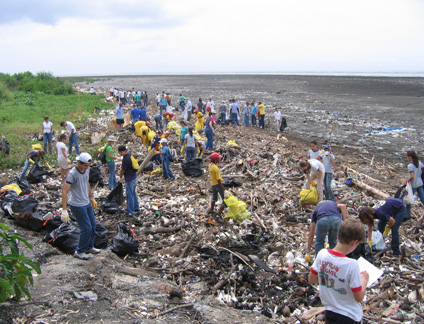
Courtesy Ocean Conservancy
In December 1988, the NPS, in cooperation with the National Oceanic and Atmospheric Administration Fisheries Service (NOAA), initiated a five-year project to sample of ten one-kilometer long sections of beaches four times per year in each of eight coastal national parks and seashores. The purpose was to gather the data necessary to
quantify marine debris problems on U.S. shores.
During the ensuing five years, we collected data on the accumulation of 79 different types of marine debris. We were interested primarily in marine debris that was harmful to wildlife, particularly ropes and nets that entangle animals and small plastic that could easily be ingested.
We found considerable variation in both the types and amounts of debris between each of the park areas in different regions. For example, Padre Island National Seashore on the Gulf of Mexico had ten times more debris including some toxic wastes than recorded in any other park.
Debris in the Channel Islands National Park was found to vary considerably by season, with much more debris accumulating in the spring following winter storms. The quantities of debris varied greatly by beach exposure to the prevailing winds and current. Episodic events such as heavy rains that washed out river beds and storm drains on the mainland were responsible for pulses of garbage that appeared on the remote island beaches. Other types of debris could be traced to various fishing activities and shipping. In 2011, we resurveyed most of the beaches from the original study to gather some baseline information that may be useful in determining the future impact of Japan tsunami debris. Monitoring marine debris is valuable as we can track changes and possibly remedy impacts of hazardous items such as nets that entangle marine mammals or microscopic plastic pellets that bird or fish may ingest.
Tsunami Debris - FAQs
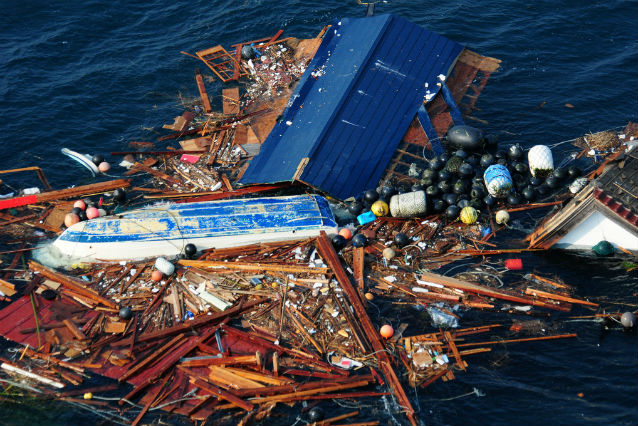
Courtesy U.S. Navy
When will the debris from the tsunami in Japan reach the U.S.?
Many variables affect where the debris will go and when. Items will sink, disperse, and break up along the way, and winds and ocean currents constantly change, making it very difficult to predict an exact date and location for the debris’ arrival on our shores.
Scientists are relying on computer models to predict the debris items’ path and drift rate. Independent models run by NOAA and University of Hawaii tell us some debris could pass near or wash ashore in the Northwestern Hawaiian Islands as early as this winter based on reported sightings of debris by the Russian ship STS Pallada, approach the West Coast of the United States in 2013, and circle back to the main Hawaiian Islands in 2014 to 2016.
Why are pieces of debris washing up now if scientists think it will take years?
Marine debris is an everyday problem and it washes upon our coasts from Asia all of the time. It is unclear if the accounts of this debris being related to the tsunami are true. Items need to be closely inspected before we can determine, if possible, that they were washed into the sea by the tsunami.
Is the debris radioactive?
There is consensus among scientists that this is highly unlikely, for several reasons: The vast majority of the debris was many miles away from the reactor, precluding any contact with the radioactive leak.
The leak of contaminated water from the reactor into the sea started days to weeks after the debris was washed out to sea. By the time the radioactive water leak developed, the debris was already in the ocean, miles away from the reactor.
Vessels coming into the United States from Japan were monitored for radiation, and readings were below the level of concern.
How can we begin monitoring the shore or report sightings of tsunami debris?
Debris from other sources is washing up on our shore all the time. If unusual types or a large amount of material washes up and it appears it might be related to the tsunami, it should be reported to the NOAA Marine Debris Program at DisasterDebris@noaa.gov. Avoid picking up unusual debris that you are not well equipped and trained to handle.
For current information go to these websites (which are also the sources for these talking points):
• NOAA Marine Debris Program
• US EPA Region 9 Marine Debris homepage
Contributors
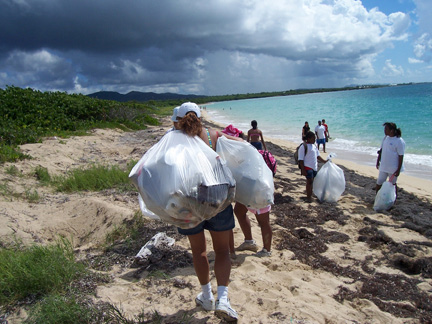
Courtesy Ocean Conservancy
Dr. Sarah Allen, PWR Ocean Stewardship Coordinator
Yvonne Menard, Channel Islands National Park
Jim Pfeiffenberger, Kenai Fjords National Park
Dan Richards, Channel Islands National Park
Editors:
John Dell’Osso, Point Reyes National Seashore
Bonnie Phillips, Cabrillo National Monument
Part of a series of articles titled Pacific Ocean Education Team (POET) Newsletters.
Previous: POET Newsletter November 2011
Tags
- channel islands national park
- kenai fjords national park
- pacific ocean education team
- pacific ocean
- marine debris
- tsunami
- noaa marine debris program
- marine debris program
- kenai fjords national park
- kenai fjords
- resurrection bay conservation alliance
- marine debris monitoring
- channel islands national park
- channel islands
- padre island national seashore
- padre island
Last updated: October 8, 2021
